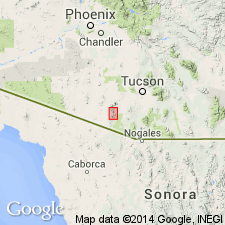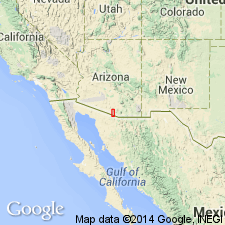
- Usage in publication:
-
- Pitoikam Formation*
- Modifications:
-
- Named
- Dominant lithology:
-
- Conglomerate
- Shale
- Arkose
- Quartzite
- AAPG geologic province:
-
- Basin-and-Range province
Summary:
Named for village of Pitoikam, Pima Co, AZ. No type locality designated. Occurs in Baboquivari Mountains between head of Fresnal Wash and Otero Ranch, AZ in the Basin-and-Range province. Divided into three members: 1) a lower conglomerate member up to 6,000 ft thick; 2) the Contreras Conglomerate Member, as much as 4,400 ft thick; 3) and at the top, the Chiltepines Member. Lower member composed of alternating beds of gray to red conglomerate, sandstone, and siltstone; most of the pebbles, cobbles, and boulders are volcanic materials, but some are limestone and quartz in a matrix of graywacke. The Contreras is conglomerate made up mostly of fragments of quartz latite porphyry. Chiltepines is shale, arkose, quartzite, and conglomerate. Rests on Otero Granite (Mesozoic?)--first used. Overlain by Mulberry Wash Volcanic Formation (Mesozoic?)--named. Is of Mesozoic? age. Geologic map.
Source: GNU records (USGS DDS-6; Denver GNULEX).

- Usage in publication:
-
- Pitoikam Formation*
- Modifications:
-
- Age modified
- AAPG geologic province:
-
- Basin-and-Range province
Summary:
Age is refined to Early Jurassic. In part equivalent to Ali Molina Formation.
Source: GNU records (USGS DDS-6; Denver GNULEX).
For more information, please contact Nancy Stamm, Geologic Names Committee Secretary.
Asterisk (*) indicates published by U.S. Geological Survey authors.
"No current usage" (†) implies that a name has been abandoned or has fallen into disuse. Former usage and, if known, replacement name given in parentheses ( ).
Slash (/) indicates name conflicts with nomenclatural guidelines (CSN, 1933; ACSN, 1961, 1970; NACSN, 1983, 2005, 2021). May be explained within brackets ([ ]).

